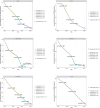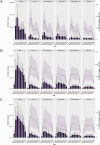Global and regional trends in the burden of surgically confirmed endometriosis from 1990 to 2021
- PMID: 40483411
- PMCID: PMC12144762
- DOI: 10.1186/s12958-025-01421-z
Global and regional trends in the burden of surgically confirmed endometriosis from 1990 to 2021
Abstract
Background: endometriosis as a common gynecologic finding significantly affects the quality of life of many women. An accurate understanding of the epidemiological characteristics of endometriosis is essential for disease control and prevention. We aimed to use the latest data from the Global Burden of Disease (GBD) 2021 to comprehensively analyze the various epidemiological indicators of surgically confirmed endometriosis and their changing trends to better measure the disease burden and help improve health management.
Methods: We delineated incidence, prevalence, and years lived with disability (YLDs) of surgically confirmed endometriosis at the global, regional, and national levels. The estimated annual percentage change (EAPC) was calculated to assess temporal trends in the age-standardized rate (ASR). In addition, we used joinpoint regression models to describe local trends in these indicators, assessed the correlation between disease burden and Socio-demographic index (SDI) levels, and used decomposition analysis to quantitatively analyze the driving factors leading to changes in disease burden.
Results: Globally, the age-standardized rate of incidence, prevalence, and YLDs of surgically confirmed endometriosis all showed a decreasing trend from 1990 to 2021. The burden of surgically confirmed endometriosis is mainly concentrated in women aged 20-30 years and declines with increasing SDI levels. The results of the decomposition analysis indicated that population growth is the main driving factor for the upward in the number of incidence, prevalence, and YLDs cases of endometriosis worldwide.
Conclusions: The overall burden of endometriosis has decreased globally from 1990 to 2021, but there are regional disparities. Managing this condition remains a major challenge, and more refined policies and interventions are needed to effectively address the burden of endometriosis.
Keywords: Disease burden; Endometriosis; Estimated annual percentage change; Incidence; Prevalence.
© 2025. The Author(s).
Conflict of interest statement
Declarations. Ethical approval: The requirement for ethical approval and informed consent was not applicable because the data in this study were secondary data and did not contain any data which could identify individuals. Competing interests: The authors declare no competing interests.
Figures






Similar articles
-
The global burden of polycystic ovary syndrome, endometriosis, uterine fibroids, cervical cancer, uterine cancer, and ovarian cancer from 1990 to 2021.BMC Public Health. 2025 May 14;25(1):1774. doi: 10.1186/s12889-025-22881-3. BMC Public Health. 2025. PMID: 40369458 Free PMC article.
-
Global, regional, and national time trends in incidence, prevalence, years lived with disability for uterine fibroids, 1990-2019: an age-period-cohort analysis for the global burden of disease 2019 study.BMC Public Health. 2023 May 19;23(1):916. doi: 10.1186/s12889-023-15765-x. BMC Public Health. 2023. PMID: 37208621 Free PMC article.
-
Global, regional, and national endometriosis trends from 1990 to 2017.Ann N Y Acad Sci. 2021 Jan;1484(1):90-101. doi: 10.1111/nyas.14468. Epub 2020 Sep 10. Ann N Y Acad Sci. 2021. PMID: 32909625
-
Global, regional, and national burden of fracture of vertebral column, 1990-2021: analysis of data from the global burden of disease study 2021.Front Public Health. 2025 Apr 30;13:1573888. doi: 10.3389/fpubh.2025.1573888. eCollection 2025. Front Public Health. 2025. PMID: 40371297 Free PMC article.
-
Global, regional, and national incidence, prevalence, and years lived with disability for 301 acute and chronic diseases and injuries in 188 countries, 1990-2013: a systematic analysis for the Global Burden of Disease Study 2013.Lancet. 2015 Aug 22;386(9995):743-800. doi: 10.1016/S0140-6736(15)60692-4. Epub 2015 Jun 7. Lancet. 2015. PMID: 26063472 Free PMC article. Review.
References
-
- Taylor HS, Kotlyar AM, Flores VA. Endometriosis is a chronic systemic disease: clinical challenges and novel innovations. Lancet. 2021;397(10276):839–52. 10.1016/S0140-6736(21)00389-5. - PubMed
-
- GBD 2017 DALYs and, Collaborators HALE. Global, regional, and National disability-adjusted life-years (DALYs) for 359 diseases and injuries and healthy life expectancy (HALE) for 195 countries and territories, 1990–2017: a systematic analysis for the global burden of disease study 2017. Lancet. 2018;392(10159):1859–922. 10.1016/S0140-6736(18)32335-3. - PMC - PubMed
-
- Shafrir AL, Farland LV, Shah DK, et al. Risk for and consequences of endometriosis: A critical epidemiologic review. Best Pract Res Clin Obstet Gynaecol. 2018;51:1–15. 10.1016/j.bpobgyn.2018.06.001. - PubMed
MeSH terms
Grants and funding
LinkOut - more resources
Full Text Sources
Medical

